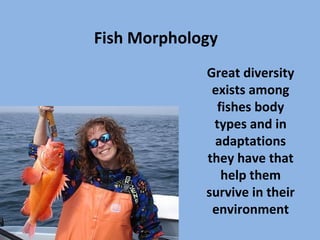Fish morphology
•Descargar como PPT, PDF•
14 recomendaciones•10,375 vistas
Denunciar
Compartir
Denunciar
Compartir

Recomendados
Recomendados
Handling is very important if fishing activity from catching to deliver it at consumer level. In this assignment i tried to give some appropriate information about good handling practice in fisheriesPost Harvest Handling of Fish

Post Harvest Handling of FishBangabandhu Sheikh Mujibur Rahman Agricultural University, Salna , Gazipur-1706, Bangladesh
freshwater aquacultureTRAITS OF IMPORTANT CULTIVABLE FISH AND SHELLFISH & THEIR CULTURE METHODS

TRAITS OF IMPORTANT CULTIVABLE FISH AND SHELLFISH & THEIR CULTURE METHODSSHUBHAM PATIDAR FISHERIES ADDAA
Más contenido relacionado
La actualidad más candente
Handling is very important if fishing activity from catching to deliver it at consumer level. In this assignment i tried to give some appropriate information about good handling practice in fisheriesPost Harvest Handling of Fish

Post Harvest Handling of FishBangabandhu Sheikh Mujibur Rahman Agricultural University, Salna , Gazipur-1706, Bangladesh
freshwater aquacultureTRAITS OF IMPORTANT CULTIVABLE FISH AND SHELLFISH & THEIR CULTURE METHODS

TRAITS OF IMPORTANT CULTIVABLE FISH AND SHELLFISH & THEIR CULTURE METHODSSHUBHAM PATIDAR FISHERIES ADDAA
La actualidad más candente (20)
Alimentary canal and feeding adaptations in fishes by nusrit

Alimentary canal and feeding adaptations in fishes by nusrit
TRAITS OF IMPORTANT CULTIVABLE FISH AND SHELLFISH & THEIR CULTURE METHODS

TRAITS OF IMPORTANT CULTIVABLE FISH AND SHELLFISH & THEIR CULTURE METHODS
Similar a Fish morphology
Similar a Fish morphology (20)
Fins and locomotion in fishes by Iram Bee M.Sc. II Year.pptx

Fins and locomotion in fishes by Iram Bee M.Sc. II Year.pptx
Fish migration (Animal Behavior) Catadromous, Anadromous

Fish migration (Animal Behavior) Catadromous, Anadromous
Más de mswilliams
Más de mswilliams (20)
Impacts of Temperature and Salinity on Marine Animals

Impacts of Temperature and Salinity on Marine Animals
Fish morphology
- 1. Fish Morphology Great diversity exists among fishes body types and in adaptations they have that help them survive in their environment
- 2. Body Shape - Fusiform • Streamlined, torpedo- shaped • Fast open water swimmers • Predators • Move tail side to side • Ex: Tuna, Swordfish, Shark, Striped Bass, Salmon
- 3. Fusiform Elfin Cove, AlaskaElfin Cove, Alaska Orient Point, New YorkOrient Point, New York
- 4. Body Shape - Compressiform • Compressed from side to side • Quick bursts of speed over short distances • Live among plants, move among narrow spaces • Move tail side to side • Ex: Moonfish, Butterflyfish Front view
- 5. Body Shape - Depressiform • Flattened top to bottom • Live on the bottom • Predators or scavengers • Flap fins up and down, swim like a bird • Ex: Halibut, Flounder, Skates, Rays Front view
- 6. Elfin Cove, AlaskaElfin Cove, Alaska Montauk, New YorkMontauk, New York Check out tail shape Check out tail shape Depressiform
- 7. Body Shape – Filiform (Attenuated) • Elongated shape • Slow • Live soft mud, sand, or under rocks • Slither like a snake • Ex: Eels, Sand Lance Side view
- 8. Caudal Fin Shape • Caudal Fin = Tail • Homocercal = symmetrical • Heterocercal = asymmetrical
- 9. Tail Shape – Homocercal-Rounded • Large amount of surface area allows sharp turns, quick starts for predator avoidance • Creates drag, fish tires easily • Ex: Northern Puffer, Clownfish
- 10. Tail Shape – Homocercal-Truncate • Allows short bursts of speed to escape predators or constant slow swimming • Less drag than rounded • Bottom dwelling fish • Ex: Killifish, Flounder, Halibut (see slide 6)
- 11. Tail Shape – Homocercal-Forked • Allows constant swimming over long distances, reduces drag • Open water swimmers • Don’t need speed for protection or to catch food • Ex: Many schooling fish, Menhaden, Striped Bass, Porgies
- 12. Huntington, New York Huntington, New York Smithtown, New YorkSmithtown, New York Homocercal- Forked
- 13. Tail Shape – Homocercal- Lunate • Half-moon shaped • Fast moving oceanic swimmers • Less drag, great acceleration, reduced maneuverability • Ex: Tuna, Swordfish
- 14. Tail Shape – Heterocercal • Medium speed • Asymmetrical – top longer than bottom • No air bladder, so tail provides lift • Reduced maneuverability • Ex: Many sharks